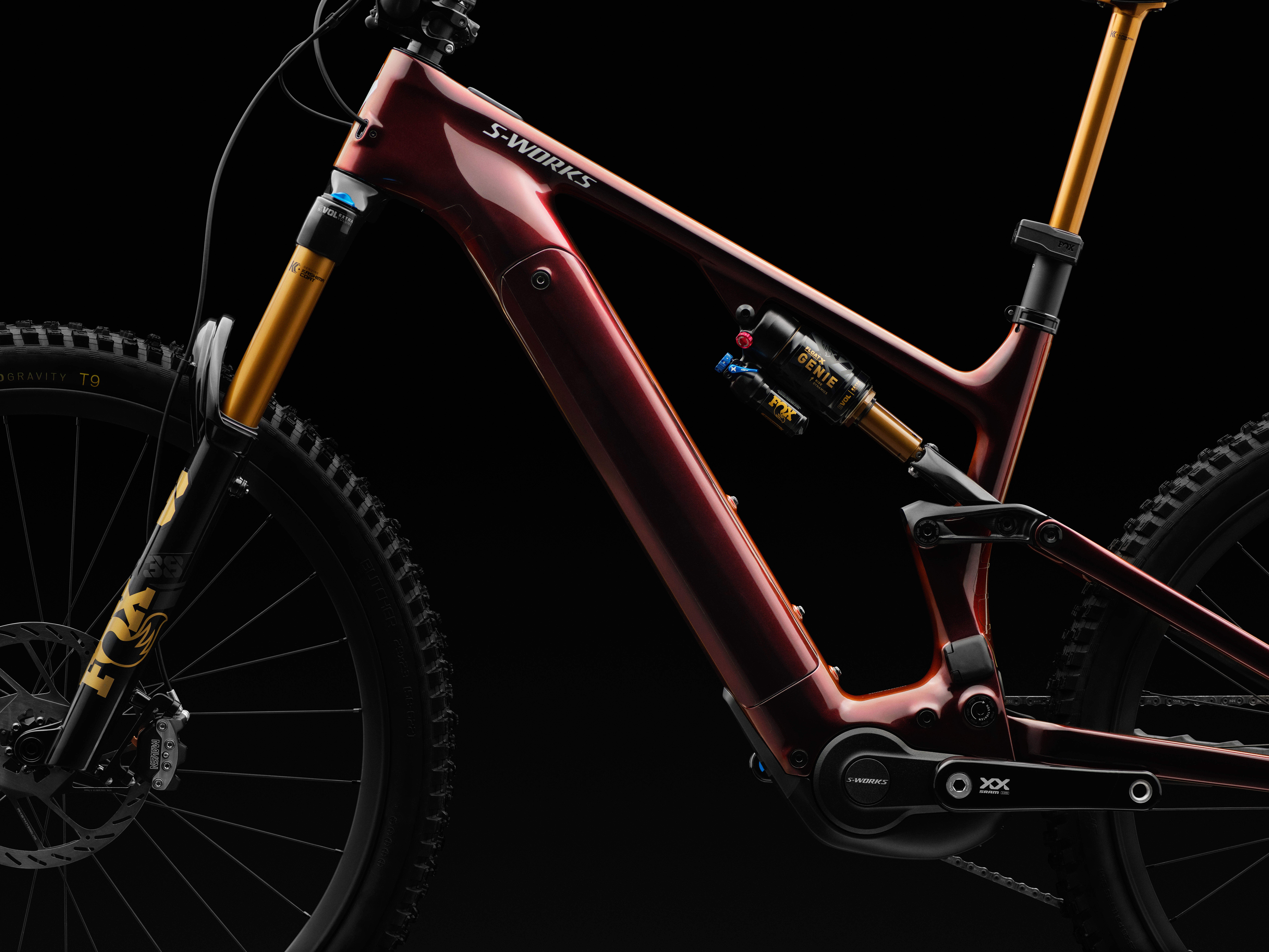DJI? Deliveroo? Disabled people? Families? You? Proposals to set a 750w peak power limit appear to be on the cards.
There is a lot of talk flying around the internet about the possibilty of the regulations and classifications surrounding ebikes being amended. The principal thing that kicked off this most recent debate was a statement by the German Bicycle Industry (ZIV). More about this later.
The arguable cause of this debate is the relatively sudden leap up in certain motors’ peak power capacity.
Most full-fat ebike motors have had around 600-700w of peak power assistance. Then the DJI Avinox motor appeared out of the blue with 1,000w of peak power. And as of this week, an update from DJI gives this 1,000w of peak power permanently when in Turbo mode not just for 30 second blasts of Boost.
Latest Singletrack Merch
Buying and wearing our sustainable merch is another great way to support Singletrack
More recently there has been the new Specialized Levo with a claimed 720w peak. And it feels like Bosch are about to unleash something soon too (possibly an update to existing Performance Line CX motors to unleash a few more watts).

What’s the problem with power?
Why is more watts a problem? Well, it’s nothing really much to do with mountain biking rider safety or trail erosion or even the forever in the background spectre of illegal de-restriction. It’s to do with pedal assist bicycles straying too far from their original remit and raisn d’être. Namely, to add a bit of extra motor power on top of the rider power going into the pedals.
Anyone who’s ridden a DJI Avinox ebike – such as the Amflow PL Carbon – will know that it doesn’t take very many rider input watts to get the motor ro give out its much hyped 1,000 watts of motor assistance. The experience is akin to using soft-pedalling of the cranks as essentially a throttle.
It’s this ‘support ratio’ issue that the bike industry is concerned about. Although 1,000w pedal assist bikes are still quite far off things like Surron e-motos in terms of power (minimum 12,500w of peak), there’s no denying that higher and higher wattage e-bikes have the potential to stray too far from regular bicycles.
ZIV
So what are ZIV – and a lot of the bicycle industry globally – proposing? In a press release called ‘ZIV positions itself on future EPAC regulations‘ the key paragraphs are as follows:
It considers the following additional parameters to be characteristic of an EPAC*:
- support ratio of 1:4 and
- support ratio of 1:6 possible up to max. 15 km/h and
- max. assistance power of 750 W at the drive wheel and [sic]
- max. weight of 250 kg for single-track** EPAC or
- max. weight of 300 kg for multi-track** EPAC
Separate framework conditions and parameters must be defined for cargo bikes weighing more than 300kg.
*EPAC = electrically power assisted cycle, basically what we mean when talking about ebikes/eMTBs.
**single-track EPAC = two wheels behind each other ie. bicycle.
**multi-track EPAC = three or for wheels ie. tricycle, four-wheel cargo bike etc.
You can see from this that the DJI Avinox would fall foul of these regulations. Both in its more-than-750w peak power and its support ratio of 1:4 (and even the support ratio of 1:6 with a speed restriction of 15km/h).
Regardless of the suggested maximum power wattage (750w), for the support ratio of the Avinox to be allowed under the new proposals the rider would have to be putting in 250w of their own leg power to access the motor’s 1000w of assist.
The support ratio at maximum speed of 15km/h (1:6) is a bit closer to what the Avinox currently does, but it’s irrelevant because the proposals suggest that 750w peak power limit. Which overrules everything.
The maximum weight limits wouldn’t be relevant to e-MTBs but would impact things like cargo bikes and bikes used for car-free ferrying of kids about or certain types disabled persons’ mobiles, as well as those big delivery/courier four-wheelers that can currently use cycle lanes.
What about mountain biking?
As mentioned, those who will lose out are users of pedal assist vehicles with more than two wheels and/or exceed 250kg. Not MTBs then. And this issue is something for the wider bicycle industry to contemplate and find a proper solution for.
What does all this mean for pedal assist mountain bikes? Possibly not that much in the grand scheme of things.
Maybe DJI will have to introduce new firmware/software to restrict the peak power to the suggested 750w. What will exisitng DJI Avinox owners do? Probably nothing. Just hope they don’t get pulled over by the non-existent Rights-Of-Way Police for an inspection.
In all honesty, the peak power of the Avinox is not the be all and end all of the motor. It’s not useable anywhere other than boring fireroad and tarmac. The more interesting aspect of Avinox was its exceptional response, overall ‘intelligence’ and fuel economy.
eMTBs will get a bit more power in MY26 (Model Year 2026) but I suspect they’ll not stray far over 700w peak power and/or 100Nm of torque. And that is totally not a problem.
Potential pitfalls
People are probably going to moan a bit about the 15km/h speed restriction 1:6 support ratio thing ie. you’ll only be able to access your bike’s 750w peak power if travelling below 15km/h. And this is almost certainly going to result in people ‘chipping’ their bike motor to derestrict this. But I also think this won’t be significantly more people than already derestrict their current ebikes.
As ever, it’s the de-restriction issue that remains. Can ebike manufacturers design-out de-restriction? Because they need to.
Also, what if DJI don’t follow the proposals and keep selling 1,000w peak power machines? Who’s going to police such ‘illegal vehicles’ riding along mountain bike trails and bridleways etc?






My ebike has 85nm and 400watts max
It feels like you have to put effort in up to about 50/60nm. Stick it in full and your legs don’t feel like they are the ones contributing Most of the effort . However ride long enough and steep enough you can still end up knackered in even at full 85nm/400 watts.
Ive not ridden the DJI but I imagine it must be quite frustrating hitting 15mph almost instantly and then having to pedal.
Is Donald Trump involved ? Sounds like a stealth tariff to me to protect the old school motor companies that cannot match the DJI output
As has been said above, I’d prefer them all to concentrate on and in order. Reliability, 1 universal mounting standard, universal removal batteries
I thought the new orbea rise was a full power bike? Ie 85nm and around 600w?
As for motor power, there will come a point when more power is pointless as long as the 15.5mph motor cut out speed exists. Once you can maintain 15.5mph up any steepness of hill, any more power is useless, I’d guess that djis 1000w is pretty much that point.
I’m not interested in max power, 750w is more than enough, I want reliability, lightweight, small form factors, efficiency.
Of course they cause more erosion – simple physics. Heavier, more speed, bigger grippier tyres with more power transferred to traction. Similar to modern heavier cars leading to more potholes. Anecdotally, many of the riders using the powerful bikes are more interested in blasting around, racing mates than concern for the environment they’re travelling through. Similar to fly camping – lack of understanding/education.
Flame away
We need a new category of electric motorbike, and get electric assist back to where it was. Electric motorbikes could be licenced a bit like mopeds.
A few countries have speed pedelec class. Halway between a bicycle and a moped
https://rideelectric.co.uk/speed-pedelec/
mmm… I’ma go with “nobody. Except maybe the manufacturers, who don’t get to make sales by one-upping each other with outrageous power claims".
Anything you can’t do with 750w, you don’t need an ebike for.
Nope it’s only 400w
They didn’t really advertise that .
The question, ‘ Who is going to police all this?’ is very relevant. It’s clear the police aren’t interested in the thousands of illegal ebikes used on the streets of every town and city so why would they bother with a few marginally dodgy emtbs? Obviously manufacturers will have to jump through hoops to make sure their products are legal but the fact it is legal to sell Surons to ride ‘on private land’ gives them a get around
Irrespective of the lack of policing it will make a huge difference to my (and probably others) cycling if there are law changes that impact access to rights of way and the general no tax/no licence/no insurance /no mot role of the ‘bicycle’ as currently is defined.
It might be true that there isn’t enough policing. But there isn’t no Policing
https://reightgoodbikes.co.uk/uk-police-seize-e-bikes-e-scooters/
A really insightful video from Alex Bike Tester featuring a recording of Bosch eBike Systems’ CEO, Claus Fleischer, talking about the history and reasoning behind the proposed 750W limit at this week’s launch of Bosch’s new power update for the CX5 motor in Riva del Garda, Italy:
UK MTB Trail Alliance # by riders for riders
Strava ! Noticed a few KOM’s at Llandegla have avg speeds that are impossible unless your on a bike that’s been de restricted
Llandeglas own rules state no de restricted bikes but clearly many do.
So how’s it going to work if a private estate can’t control law breakers?
Simple in it really . E-bikes will need to be licensed and pay road tax
slightly tongue in cheek, but actually might be the best route to go. Might mean less fires in homes
Always struck me as odd that the max power was allowed to be than a tdf rider can do for any length of time. Just limit them to what an average rider can sustain. Say 200w. Why wouldn’t that be good enough? (Ideally that would be total out including the rider). More in keeping with the original intent of making cycling available to those who’d otherwise not be able to cycle. .
The rules state a reasonable 250w. Then some one said are that’s average power. The peak can be higher. So i thought about it and i could see a need for a higher max. Initially i thought a fraction of a second to get over a dead spot in the pedal strike. Then i thought a few seconds for pulling away from rest or a steep obstacle. Maybe 30 seconds wood be generous. Turns out you can’t exceed an average of more than 250w for 30 minutes. I have no idea how anyone can up with 30 minutes
If that was 250w max then fine, but it’s 250w plus whatever the rider is putting out. Seems way to high.
The test looks at how the motor performs at 250W or whatever the max continuous rated power is – it’s run at the stated power and the test looks for stable operation, if stable (temps or resistance) at that power it passes. I would expect a 250W motor to run ok at 250W for more than 30 mins on that basis.
Depends on the overall weight and work being done, eg a cargo bike or a commuter with a few days worth of kit riding in a hilly area who doesn’t want to be sweaty arriving at work. They’re all EPACs alongside e-MTBs and the regs currently need to fit all.I think max speed limit makes sense alongside max continuous power – higher outputs for a short period just gets you up a steeper hill with a heavier load, you still max out at 15.5mph whatever power you have. But it was inevitable that e-MTBs would eventually go too far within that and make bikes that were too quick up to speed or breaking traction etc. ‘Hobby’ use e-MTBs should be restricted imho, it would be a shame if cargo bike scope was limited by wide-ranging regs though.
Hmm I watched that thinking it smacked of a more grown up version of Donald Trump
Basically he was saying we have rules in Europe that we have agreed and lobbied governments to setup. If you want to join our club play by our rules or we will try and not let you in.
There was also a bit of we have been caught with our pants down by DGI, so using the law to stop them
However I do think the bit about when dies an ebike becomes a moped is valid, but it’s clear the industry set the rules (by lobbying) and now it’s not happy that newcomers to the market are beating their products
Is that ok? The rules were set up by CEN, they’re within an ISO standard. The industry has influence in that but it’s not an entirely commercial thing. It’s mainly about what’s considered safe and reasonable for a product class. The standards are updated to cope with changing tech or risks that become apparent (eg the mechanical tests for disc brake frames and carbon forks changed recently), though I don’t know why peak power wasn’t part of the EPAC ISO standard to begin with.
Undoubtedly an element of that but unlikely it’s the main driver. Bosch or Shimano could have made a 1000W or 1500W peak or 100+ Nm torque motor by now but they didn’t. Perhaps some brands are not focussed on ‘MAX POWER!’ sales lines and can see the challenge to perception of the category from excessive power e-bikes. But as I said, unsure why max power/torque wasn’t part of the standards before – perhaps the focus was more on cargo bikes than what e-MTBs may become.
No body loses .They just don’t get their own little wants. There is no need at all for more power for recreational needs. That is just want. There is no need for more power for much commercial use, that’s want by the delivery riders, most of whom need regulating but sadly they are a product of a lazy society which is another can of worms. No one needs something 10 minutes quicker. The only justifiable use for more power might be for local authority type stuff such as those used to pull trailers . I am not so sure that the police don’t want to do something, the coppers I know do, but there isn’t the money. With my stand alone motoring police force with fine with two zeros stuck on the end there would be.
no such thing as UK CA, and no it wouldn’t.
BTW Mods the first tranche of comments aren’t appearing under the article for me. using opera on win 10.